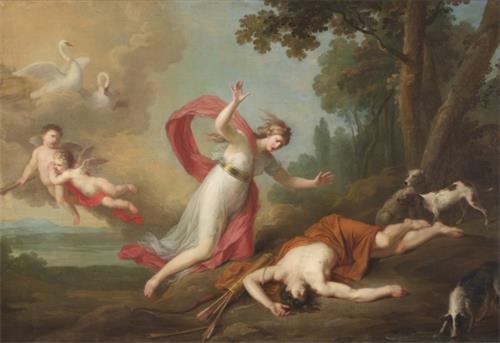
Rooted in ancient Greek mythology, this tale takes on a unique artistic charm through Titian’s brushwork.
The story originates from a myth about the deep bond between Venus, the goddess of love and beauty, and the handsome youth Adonis. According to legend, he was born from a miraculous event: Princess Myrrha, having angered Venus by boasting of her own beauty, was cursed and transformed into a tree. Venus, captivated by the child's extraordinary beauty, was filled with a deep protective instinct and decided to raise him herself.
Adonis grew up surrounded by divine love and protection. However, To resolve the situation, Zeus ordered that Adonis would spend one-third of the year with Venus, one-third with Persephone, and the last third wherever he wished.Under her care, Adonis was shielded from the hardships of life, preserving his purity and innocence to such an extent that he came to be known as the "eternal child." Yet, this very protection would foreshadow his tragic fate.
As Adonis grew older, he developed into a young man of exceptional beauty and skill, earning the admiration of everyone around him.he stayed uninterested in love, choosing instead to wander the wild and indulge in the excitement of hunting. One fateful day, Venus encountered him as he prepared to go hunting. Unable to suppress her anxiety, she pleaded with him, warning of the dangers that lay ahead. However, Adonis, steadfast in his resolve, dismissed her concerns and eagerly broke free from her grasp, eager to prove his independence.
At that moment, an inexplicable sense of dread filled Venus’s heart. She foresaw a calamity, yet she was powerless to change Adonis’s course.
As predicted, tragedy struck. During the hunt, Adonis encountered a ferocious wild boar, which inflicted a fatal wound upon him. When Venus received the dreadful news, she rushed to his side, only to find his lifeless body. Overcome with grief, she wept uncontrollably.
Yet this was not the end. Moved by Venus’s anguish, Zeus granted Adonis the gift of rebirth—allowing him to return to the earth each year, forever youthful, to reunite with Venus. Thus, Adonis became the god of vegetation and beauty, eternally cycling between life and death. The rose, once white, turned red upon contact with Venus’s blood, symbolizing her deep and everlasting love for him.
Venus and Adonis is more than just a myth about love—it takes on a deeper artistic significance through Titian’s masterpiece. Yet, Adonis remains unmoved, breaking free from her embrace and rushing toward his destiny. Venus’s sorrow and helplessness are vividly depicted, embodying the inevitability of love and loss. Her longing gaze and outstretched hands amplify the poignancy of the moment, making the tragedy all the more inescapable.
Titian’s masterful use of oil paints, color, and composition brings this tale to life with striking emotional depth. This artwork is not merely a visual representation of mythology but an artistic elevation of love and beauty itself.

Napoleon,Josephine
Napoleon and Josephine: An Imperial Love That Could Never Be Fulfilled
The love story of Napoleon and Josephine unfolds like a turbulent dream—an intricate emotional epic born from a political marriage.

Tigers
Two Tigers Reunite and Have Cubs After Crossing 200 km—Why Did Scientists Separate Them in the First Place?
In Russia's Far East, the conservation of Amur tigers (also known as Siberian tigers) has achieved a surprising and heartwarming success.

Bicycle
This Bicycle Sells for $1 Million! How Do Technology and Luxury Merge on Two Wheels?
The House Of Solid Gold, an American company, has launched the world’s most expensive bicycle—named "Beverly Hills"—with a price tag of $1 million.


